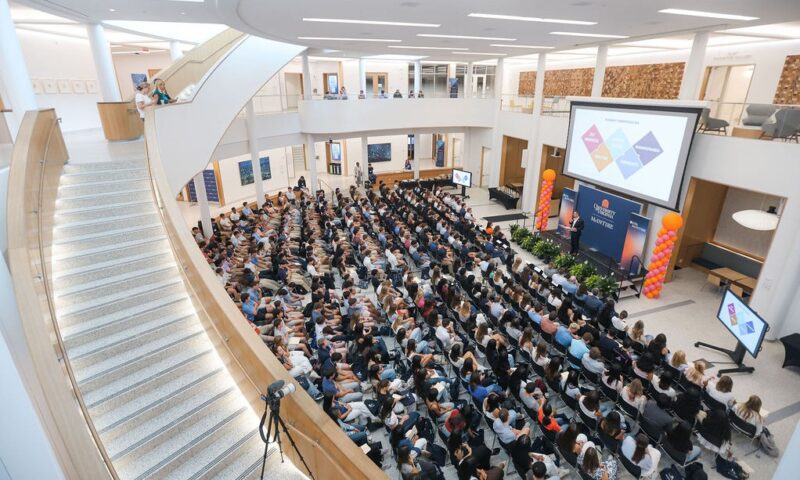Since its inception, McIntire’s M.S. in the Management of Information Technology has been at the forefront of innovating its curriculum to examine the potential of new technologies and the value they bring to the business environment. In years past, the program considered major catalysts like enterprise systems, mobile and e-commerce, big data, and business analytics, but none have had the extraordinary potential for pervasive transformation as generative artificial intelligence, or “genAI” for short. As it changes and grows in power and applicability—seemingly by the week—the evolving tech is already reshaping industries and how they do business, thereby requiring a new level of attention in the MSMIT program as well.
McIntire’s early adoption and integration of genAI into the MSMIT curriculum arrived under the leadership of the program’s Director, Professor Stefano Grazioli.

Stefano Grazioli
“GenAI came to the fore three years ago, at least for the larger business world, and we were among the first programs to incorporate genAI into our curriculum,” says Grazioli, explaining that by early 2022, specific genAI content was already added to the curriculum. “Since the beginning, we focused on real-world commercial applications of genAI rather than its engineering aspects. Because our curriculum centers on understanding the business value of information technology, MSMIT students are exceptionally well-positioned to discover and exploit the new capabilities enabled by innovative technologies such as genAI.”
Planning for Strategic AI Use in MSMIT
Incorporating practical applications that solve real-world business challenges is MSMIT’s bread and butter—its curriculum sits squarely at the nexus of tech and business. As genAI is influencing more of what goes on in our world, it is simultaneously reimagining processes and influencing how people work across industries. It therefore requires a business lens to weigh its costs and benefits.
“There’s going to be a bottom line because there is the impact on the organization, the employees, the customers, and a whole set of dimensions on which we judge any innovation,” shares Grazioli. “It’s important to find the right type of application—something that MSMIT students are ideally positioned to find out because they have an interest in technology and experience in business. They’ve seen many projects’ realities, and they have a better sense of what may work or not work in the real world.”
Enterprise & Cloud Systems Manager Jack Robbins had originally built a platform in early 2024 as a secure space for the McIntire community to explore genAI. “Unlike commercial tools, all data stays within McIntire’s environment, which makes it ideal for experimenting with sensitive or course-specific content,” he says, noting that he later added the functionality to use retrieval-augmented generation (RAG) to “reduce hallucinations by grounding responses in reliable, curated materials, critical in an academic setting where accuracy is non-negotiable.”

Ryan Wright
Seeing a pressing need to incorporate more of the tech into the degree program, Professor Ryan Wright, who teaches MSMIT’s Managing Digital Change and Project & Product Management courses, invited Robbins to help create McIntire-based course-specific AI tutors with his platform in early 2025. He collaborated with Professor Bryan Lewis to scope the project, review faculty proposals for tutors, and support the faculty volunteers to help integrate the tech.
“As genAI becomes more popular, it’s important that our MSMIT graduates feel confident not only in strategically applying this technology across organizations, but also in gaining hands-on experience with these tools,” Wright says. “Our aim is for graduates to become skilled in evaluating, applying, and strategically using genAI solutions in their workplaces.”
In his role as an instructor, Lewis, like Wright, covers AI’s impact in cybersecurity, reviewing AI tools in business problems and solutions alike.

Bryan Lewis
“AI is now both a powerful defense mechanism and a potent threat vector in cybersecurity,” says Lewis, pointing out how the tech is misappropriated by bad actors in phishing schemes and more, but also applied to fight them. “Traditional cyber defense methods for protecting humans are no longer effective in a world where AI attacks are indistinguishable from legitimate correspondence. Understanding the threats and opportunities is vital for the emerging IT leaders we serve in MSMIT.”
A GenAI Ally in Practice

Jingjing Li
Professor Jingjing Li, with experience in the AI area, answered Wright and Lewis’s call for faculty volunteers. Conceptualizing within the parameters of the intended program to focus on a single group project requiring two or three students working in tandem with each other and the AI tutor, Li designed a new predictive analytics assignment for MSMIT Mod 3 on digital innovation, AI, and analytics, that was launched in February 2025.
Robbins, supported by Enterprise and Cloud Systems Engineer Lawson Johnson, who optimized the workflow for faster and more contextually relevant responses from the tutor, worked directly with Li to prepare it for fast implementation in her course. “One of the biggest challenges wasn’t just time, it was how fast the AI landscape kept shifting week to week. Staying ahead of emerging tools and model capabilities while developing something stable, secure, and useful required constant iteration and learning,” recalls Robbins. “That said, those constraints forced us to stay focused and build something practical that delivered real value quickly.”
Li’s further development and implementation of the AI tutor were facilitated by writing a detailed and thorough prompt about the tutor’s role, expertise, tone, and teaching approach. Rather than simply provide full answers like a typical chatbot might attempt to do, the tutor responded in a manner that provided follow-up questions and pertinent explanations about various details, helping students to think differently about issues they were experiencing and to find possible solutions.
For the assignment, Li tasked students with using a Jupyter Notebook for Python to predict customer churn for a telecommunications company. Answering a series of 20 nuanced questions, the AI tutor became part of the learning process, supporting their efforts as they studied predictive analytics.
The results of the experience proved to be overwhelmingly positive.
“It was an amazing success,” says Li. “I feel that it is a huge accomplishment, and the students also liked it because some of them shared in their reflections that they would never have imagined that they could make sense of the coding and to answer such in-depth questions about data science,” she says, noting that some students manage data scientists, but they didn’t previously have the proper knowledge to discuss any details about their specific activities. “Through these exercises, they feel empowered and can have a more effective and efficient conversation with scientists on their team.”
Another major benefit from the assignment was the way it allowed for higher-level thinking and better use of Li’s time both in the classroom and during office hours. “Confidence and self-efficacy are increased, and that’s reflected in their class participation and office hour visits because they are empowered to ask more questions. Therefore, during class, I can focus more on open-ended, more interesting discussions with more interactivity,” she says. “Another learning outcome is that, because the AI tutor is 24/7, it’s very flexible for working professionals to accommodate their schedule. With this flexibility and ubiquitous access, they were able to accomplish more, especially like these kinds of technical questions.”
AI Coaching Better Business Communication

Kiera Allison
For Professor Kiera Allison, AI is a tool that can help MSMIT students as it guides them to become better thinkers and, in turn, develop their own voice in a way beyond simple grammatical or structural correction.
During the fall of 2023, she began to rethink the business writing component of Mod 2 as AI became more readily available for widespread use.
“I was interested in having a conversation, not just about how to use AI to expedite the writing process, but the implications of AI for what good quality writing is going to be,” she says, explaining that readers’ expectations are changing. “Because business writing instruction has been so focused on being clear, being audience-focused, being everything that AI can do so much of already, I felt like I needed to pivot to teach them to write in this particular space where AI exists.”
During the first half of the spring 2025 semester, she collaborated with Robbins and Johnson, designing a series of AI tutors to provide students with writing feedback and assignment guidance. Her initial focus was the business memo—a McIntire writing genre staple. “It’s a very complex, counterintuitive way of writing and, even if they write a lot of memos, they already have their own sense of what a memo is,” Allison says. “The challenge is learning how to take feedback, enact that, and take enough time for that process.”
Students wrote two memos for two different faculty members, which Allison reviewed. “That was when I introduced my elaborate AI feedback prompt to show them how they could use AI to coach them on the assignment. It was an experiment on an assignment that was useful for students to see how the AI could help give them some of the same kinds of feedback they were getting from their professors,” she says.
And while some students have voiced initial resistance about using AI because they don’t want to give up ownership of their writing, she explains that using targeted questions without asking the tool to write or revise can help them improve their communication overall. Students—even professional ones who work in tech or tech-adjacent jobs—are surprised to discover they can use AI in a coaching capacity.
“They’re in IT, they’re tech savvy, but they have not necessarily thought about the technology in the context of what it could do for their writing,” Allison says. “When they see it coming together, they’re impressed.”
Future Integration of AI at McIntire

Emma Zhao
Once launched, using the tools effectively is an ongoing process, one that requires constant analysis. Professor Emma Zhao has been working with Wright to reflect on the current and future genAI initiatives within McIntire’s program.
“We are reviewing iterations of the AI tutor to ensure it meets the needs of our students while simultaneously evaluating its ability to enhance learning outcomes for courses in our curriculum,” says Zhao.
Li hopes her colleagues will consider the use of AI tutors in their own classes as well. “AI has the potential to be applied or transferred to other modules and other programs, and I encourage faculty to do so,” she says. “Students will be empowered to learn more, so AI is going to be a big disruption. If we have a student body using tools like Microsoft Copilot, I feel like our faculty should take a proactive approach and leverage the summer to learn more from the many resources available.”
Allison has continued experimenting with AI to guide students on assignments, give feedback on their writing, and provide the kind of dialogue that will support them to further develop their thinking and communication skills as they progress through the program. “The next step for MSMIT is to create a really robust assignment-trained AI memo tutor to get students from Mod 2—when they’re learning how to write a memo—to Mod 3, when they are writing for a real-world executive audience and also preparing to dialogue and field questions about the contents,” she says.
Robbins says that they are also exploring integrations with other McIntire tools and increasing the data sources agents can learn from, like class recordings, to deliver even more tailored responses to queries. “We are exploring ways to expand the platform beyond course-specific tutors, such as creating lecture companion agents that can help students review past content or ask follow-up questions, or faculty assistant tools that summarize student feedback or help draft course materials,” he says. “The more we can tailor these tools to McIntire’s unique needs, the more value they’ll bring to both faculty and students.”



